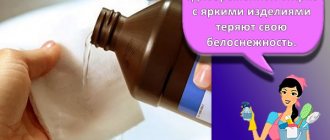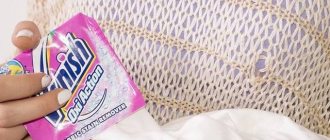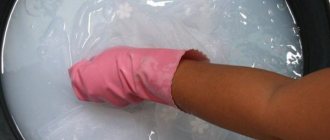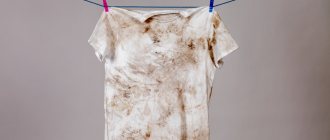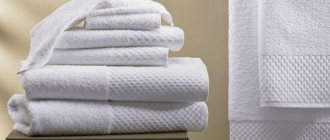If there is a need to bleach white synthetic clothes or underwear with lace inserts at home, you need to decide what products will be used for this. Their choice, first of all, depends on what defect you have to cope with:
- remove stains;
- refresh gray things;
- remove yellowness.
You can whiten synthetics, including removing stains, either using special factory products - bleaches and stain removers, or using “grandmother’s secrets”.
How can you not bleach synthetics?
Sometimes publications contain advice on bleaching white items, which are absolutely not suitable for synthetic fabrics.
Synthetics must not be subjected to the following manipulations:
- boil and wash at high temperature;
- soak or wash with products containing chlorine;
- dry in direct sunlight.
- squeeze after bleaching.
Chlorine-containing bleaches have an unpredictable effect on synthetics and in most cases lead to yellowing of the fabric. Drying in the sun has the same effect. But boiling can lead to deformation or complete damage to the item.
Bleaching by fabric type
It turns out that there are a lot of folk methods. This is not a complete list; the most popular and accessible ones are collected here. But do not forget that white clothes are made from different materials: silk, wool, linen, cotton, polyester.
And the means described above are not at all universal. And before you start bleaching, you need to figure out what type of fabric is in front of you and what can be used on it and what is strictly prohibited.
Synthetic fabrics
Lavsan, fleece, acrylic, polyester and other fancy names. If you know that your white blouse is made of artificial materials, remember the main rule: temperatures above 40 degrees do not apply to them. So any bleaching should only be done in warm water.
To return synthetic items to their original appearance, you can use the following means :
- peroxide;
- boric acid;
- potassium permanganate;
- table salt;
- ammonia;
- soda
Important : if you use store-bought products for synthetics, choose only those that do not contain chlorine. They will cause the fabric to turn yellow.
Silk
A white silk blouse, beautiful underwear, luxurious bedding - for such things they often use fabric that is considered royal and requires appropriate treatment. Therefore, it is impossible to bleach it with harsh products containing chlorine.
Before proceeding to the process, the silk product must be rinsed in warm water. Do not rub, wrinkle or twist the fabric. It does not tolerate rough mechanical impact.
products are suitable for whitening silk items :
- hydrogen peroxide;
- sea salt;
- ammonia;
- baking soda;
- lemon acid;
- natural citrus juice.
Lemon juice should be used as follows. For 1 liter of water you will need 2-3 fruits. Squeeze them into warm water and soak the silk item overnight. This will not only make it whiter, but also refresh it. The method of using other means was discussed above.
Advice : if you have the desire and opportunity to use store-bought products for whitening, pay attention to powders and gels based on thiourea dioxide. These include “Diola”, “Rime-2”, “Universal”, “Lily-3”.
Wool
Washing items made from this material requires compliance with strict rules. Remember: no aggressive ingredients, forget about high temperatures and intense spinning.
Of all the home remedies for whitening described above, the following are applicable to wool products:
- hydrogen peroxide;
- soda;
- lemon acid;
- ammonia;
- salt;
- chalk.
If the use of the first five means has already been discussed, then we need to talk about the last one in more detail. To use it to bleach a woolen item, make powder or crumbs. Prepare a solution at the rate of: a kilogram of chalk per 3 liters of warm water.
Soak a white woolen item for an hour, and then rinse with a special softening conditioner.
If there are serious stains on a woolen item that folk remedies cannot remove, you can use white, but this must be done extremely carefully.
You should prepare a solution of very weak concentration: only 50 ml of whiteness per 8 liters of water. Soak your clothes in it for half an hour, then rinse and dry.
Cotton and linen
Cotton and linen are quite durable fabrics. This is exactly the case when it is possible, and sometimes even necessary, to use aggressive whitening agents. The only caveat: you cannot treat linen and cotton items with chlorine-containing bleaches too often.
To return a cotton or linen product to its original boiled color, dilute 100 ml of white in 10 liters of water and soak the items for an hour. After this, machine wash at high temperature.
Important : Do not use chlorine bleaches on children's clothing and bedding.
Linen and cotton items can be bleached using the following means :
- ammonia;
- turpentine;
- blue;
- vinegar;
- peroxide;
- potassium permanganate.
We return white color to gray things
There is a chance to bleach gray synthetics using regular salt. To do this, things are soaked in warm water with added salt - 600 g is mixed in 10 liters of water - after which they need to be rinsed well and washed with powder.
Another way: using soda and ammonia. 10 tablespoons of soda and 2 tablespoons of ammonia (3%) are diluted in 10 liters of warm water, the clothes are soaked for several hours (from 3 or more). After soaking, you need to wash with powder to wash out the softened particles that give the fabric a grayish tint.
Advice
If the fabric has turned gray from prolonged use or frequent careless washing, it is unlikely to be bleached. In addition, pellets form on the surface of such clothes, which also give an unkempt appearance, so “reanimating” them will still not give the expected effect.
What to do if the blouse is dyed or faded?
Often, due to carelessness, things are dyed; the appearance of a new color on a white blouse is unacceptable.
You can bleach your wardrobe items using the following methods:
- if a color change was noticed immediately after washing, it is recommended to wash the blouse again with bleaching powder in the standard cycle,
- carry out bleaching in a manganese solution,
- use soda solution for soaking.
Attention! The water in which dyed items are bleached should be warm and not too hot; boiling water will only fix the color on the item.
How to remove yellowness?
White items can turn yellow under the influence of many factors. Sometimes it is quite easy to restore the original whiteness at home, sometimes you have to make an effort, and there are cases when it will no longer be possible to restore the original color, for example, when synthetic fibers have entered into a chemical reaction with chlorine.
Causes of yellowing:
- organic particles;
- traces of perfume or cologne;
- washing in water with a high content of magnesium salts;
- use of untreated water (with rust);
- not thoroughly rinsing after washing (including if the machine’s filter is clogged);
- washing white items with colored laundry powder;
- mold.
Organic particles are traces of our body on clothing. This is not only sweat, but also dead epidermis. If you wear a white item at least once and do not wash it, and then put it in a closet for long-term storage, it will most likely turn yellow. The same thing happens if things are poorly washed after use. You can whiten such yellowness using ordinary laundry soap.
- Soak clothes in cold or slightly lukewarm water for several hours.
- Rub with laundry soap (72%) to obtain a rich, dense foam.
- Pour hot water and soak for about another hour.
- Wash and rinse thoroughly.
- Rub with soap again and repeat washing.
Advice
Poorly washed or rinsed items are more difficult to wash, and the procedure may have to be repeated several times.
Small yellow spots that appear some time after washing may well be mold. After all, mold on things can be yellow and whitish, and not just black. To deal with such stains, you can use ammonia. For these purposes, both a technical aqueous solution of ammonia (25%) and the well-known ammonia alcohol, a 10% solution, are suitable. It is used as follows:
- in 10 liters of warm water dissolve 1 tablespoon of a 25 percent solution or 4 tablespoons of three percent ammonia;
- things are soaked for several hours and then washed in the usual way;
- When washing, in addition to soap or powder, you can also add ammonia, but in a smaller proportion.
We recommend: Tips for washing down pillows at home
The same bleaching method is used if the water contains a high content of magnesium salts.
Advice
Ammonia can be added during washing for prevention. Then yellowness does not appear on the clothes.
If yellowness appears from washing in water that has not been treated with rust, in addition to ammonia, you need to add hydrogen peroxide: 200 ml per 10 liters of water. There are two more recipes that can help cope with this problem:
- soaking in sulfur-containing solutions;
- use of peroxide bleaches.
A sulfur-containing solution can be prepared from ordinary mustard (powder). 100 g of mustard is thoroughly mixed in a small amount of water and then diluted in 10 liters. Things are soaked and then washed in the usual way. The water for soaking should be as hot as possible, so this method is not suitable for clothes that can be washed up to 50 ºC. More effective is the use of peroxide bleaches.
If possible, you can bleach clothes with sodium hydrosulfite - 2 tablespoons per 10 liters of water. This drug is used to soften water in boilers, so it is sometimes available in the households of residents of private houses. If it is not available, 30 percent hydrogen peroxide (perhydrol or hydroperite) or ordinary three percent peroxide is suitable: 30 ml of hydrogen peroxide or 2 tablets of hydroperite are added to 10 liters of water at a temperature of 30 ºC. To enhance the reaction, you can add a little soda ash. Synthetics are soaked in the prepared solution for 20-30 minutes. Soaking is done in plastic containers.
Features of materials
Before you learn how to wash a white blouse, you should get acquainted with the characteristics of certain types of fabrics.
This will determine which products can be used in care or washing, and which absolutely cannot.
In addition, yellow stains and gray deposits can only be removed by individually approaching each product.
- Thin fabric (silk, etc.) requires special attention. When caring for products made from this material, you must completely avoid using products that contain chlorine. Their use may lead to irreversible destruction of the material, and then the blouse will no longer be saved. Items that require delicate care are best washed and bleached using optical products specially designed for this purpose. They perfectly remove dirt and are completely safe for humans.
- Synthetic fabric is a fairly stable material, so when caring for it you can practically not limit yourself in choosing cleaning products. However, you should avoid washing and bleaching in water temperatures above 40 degrees Celsius, as this causes deterioration of the synthetic material.
- Natural fabrics (cotton and linen) are the strongest and most durable. Caring for them is the simplest and most pleasant - they can withstand boiling, washing in hot water, and chemical cleaning agents.
Removing stains
For any synthetics, except acetate fabrics, the following mixture is used to remove stains: 5 parts alcohol, 5 parts tartaric acid, 2 parts citric acid. The result of mixing should be a paste. It is applied to the stain and rubbed in 5-10 minutes before washing.
A few more recommendations for removing stains from light-colored synthetics.
- Sweat stains can be washed off if 2 aspirin tablets are crushed and dissolved in 100 ml of cold water, and the resulting solution is applied to the contaminated areas 2-3 hours before washing.
- Grease stains are removed with salt or chalk. Chalk powder or salt is rubbed into the stain, and after a few hours it is removed with a brush. This method is only suitable for fresh stains.
- Ink stains are removed by soaking and washing the stained area in fresh milk or curdled milk.
- You can try to remove the resulting rust stain with lemon. A lemon wrapped in gauze is applied to the stain and pressed with an iron.
We recommend: How to quickly and cost-effectively return the original color to black clothes at home?
Reasons for discoloration of synthetic fabrics
Fibers obtained artificially acquire a yellow or gray tint over time. The reasons can be very different. Sometimes this happens due to low-quality washing powders or incorrectly selected temperature conditions. Some housewives forget to sort their laundry. As a result, colored fabrics fade and white fabrics take on a gray tint.
During wear, clothes become saturated with dust. Human skin secretes waste products (sweat, fat), which impregnate the fibers, and they cease to shine white. We have studied effective methods and are ready to share our secrets.
Chemicals for whitening synthetics and removing stains
Chlorine-containing bleaches should not be used on synthetics. However, today there are effective products on sale that can bleach fabric well and do not damage synthetic fibers.
Here are a few products that have proven their effectiveness and are suitable for synthetics.
- Amway Pre Wash Spray. Apply to fabric and wipe with a sponge.
- Antipyatin soap. Things are soaped 10-15 minutes before washing. To enhance the effect, you can add soap to the powder.
- Amway SA8 powder. Suitable only for fabrics that can be washed in water at temperatures above 30 ºС. Added during soaking.
How to bleach different types of fabric
Modern designers and clothing manufacturers offer a large number of white blouses made from various materials to choose from. They can be classified into artificial and natural fabrics, which can be bleached differently.
Important! To lighten synthetics, it is better to use more gentle cleaning methods; for natural fabrics, radical methods can be used, but if the fabric has a dense structure.
- Synthetic blouses can withstand any bleach, but with one condition - the water temperature should not be higher than 40 degrees.
How to avoid stains or yellowing?
How to properly wash and store white synthetic items so that they do not age? There are several secrets.
- Before washing, sort, separating white items.
- Synthetics, wool and cotton also cannot be washed at the same time, as they have different washing temperatures.
- Before washing, underwear should be soaked in cold water for at least an hour.
- Prepare water for washing: for white clothes, use settled or filtered water, and if the water is hard, soften it with soda.
- Do not store white items ironed.
- Do not use optical brighteners frequently: they can be used no more often than after 3 washes.
- Do not put wet clothes in the closet.
- Make sure that the drain filter in the machine does not become clogged.
If you follow these recommendations, you can prevent “unauthorized” changes in the color of light-colored synthetic items. If such a nuisance has occurred and, while taking out your favorite underwear or blouse from the closet, you find stains, a yellowish or grayish tint, the above tips will help you bleach your clothes at home and enjoy the freshness of your clothes.
Useful tips
Many women are concerned about the issue of washing white clothes made from synthetic fabrics. But initially it is better to think about how to properly care for and store such things.
There are several recommendations for this:
- Before washing, you need to sort things. Whites should be washed separately from colours.
- Woolen, synthetic and cotton fabrics should not be washed together. This is due to the fact that they need different temperature conditions.
- Underwear must be pre-soaked in cool water.
- To wash white items, you need filtered water. To soften the water, you need to add a little soda.
- White items do not need to be kept ironed.
- Bleach should be used very carefully. Often they cannot be used, otherwise the fabric will be deformed and its structure will be disrupted.
- Wet items should not be placed in the closet, otherwise there is a high risk of mold growth.
Caring for synthetic materials at home is easy. It is very important to follow all rules and recommendations.
Whitening at home: what you need to know
If your favorite sweater has changed color or an expensive set of underwear has turned gray after washing, don’t despair, you can try to return it to whiteness. But do not use harsh bleaches, especially if the product has lace inserts. Don’t rush to run to the store for specialized products. Often you can solve the problem yourself.
Laundry soap
Try bleaching the item with laundry soap. Rub the fabric thoroughly with it and leave for 15 minutes. Rinse thoroughly, gently wring out and hang to dry.
Soda and peroxide
Baking soda and peroxide effectively remove yellowness. Fill a basin with 7 liters of warm water. Add 150 g sodium bicarbonate and 20 g hydrogen peroxide. Add laundry detergent according to instructions. Leave for 3 hours and rinse.
Salt
Synthetic fabrics are well bleached by salt. To achieve greater effect, you can add ammonia. For 7 liters of water you will need 3 tablespoons of sodium chloride and 40 g of ammonium hydroxide. You can leave the item in this solution overnight.
Housewives note that each method is effective. If one doesn't do the job, try another. Fabrics differ in composition; you need to choose the most effective one for the base fibers.
